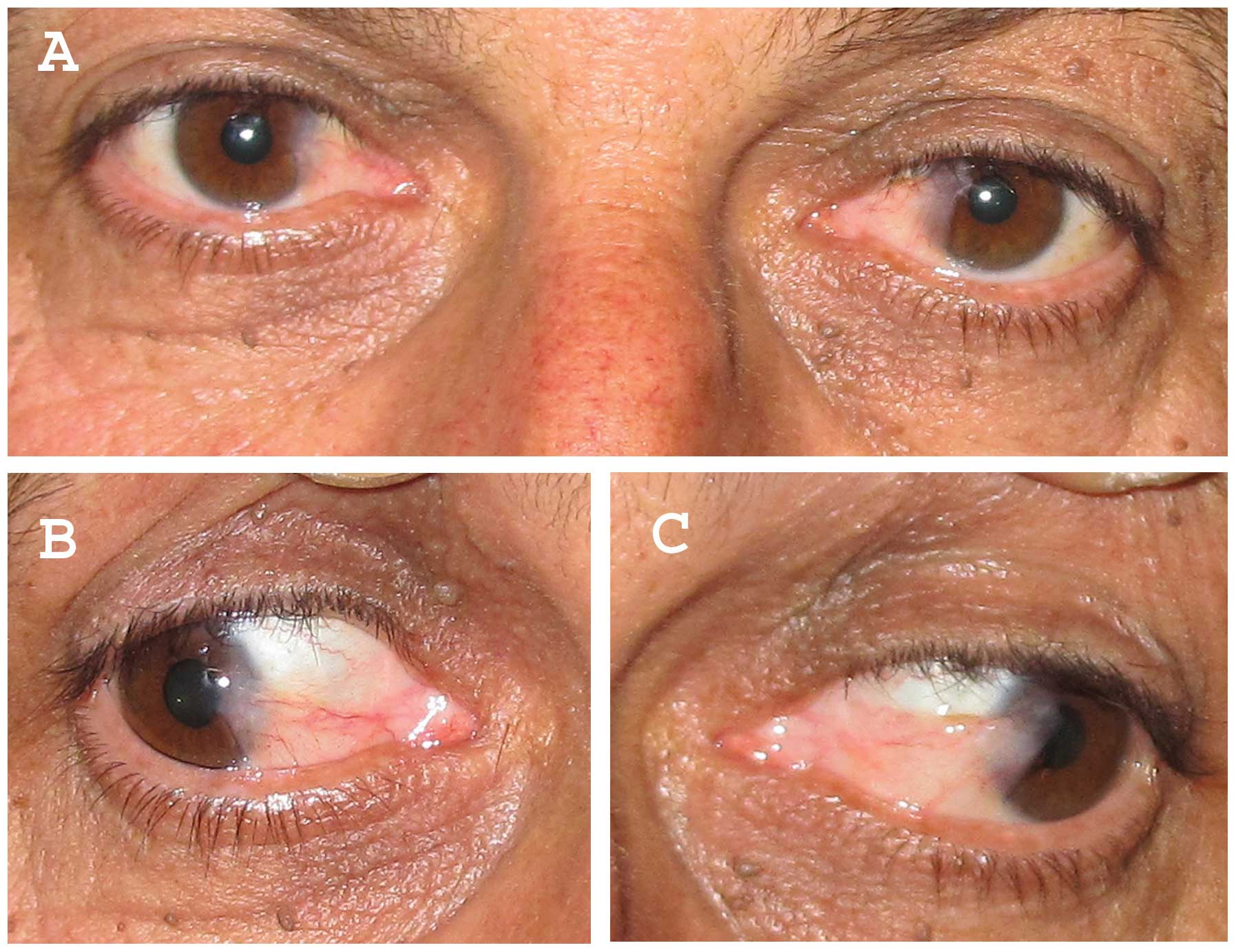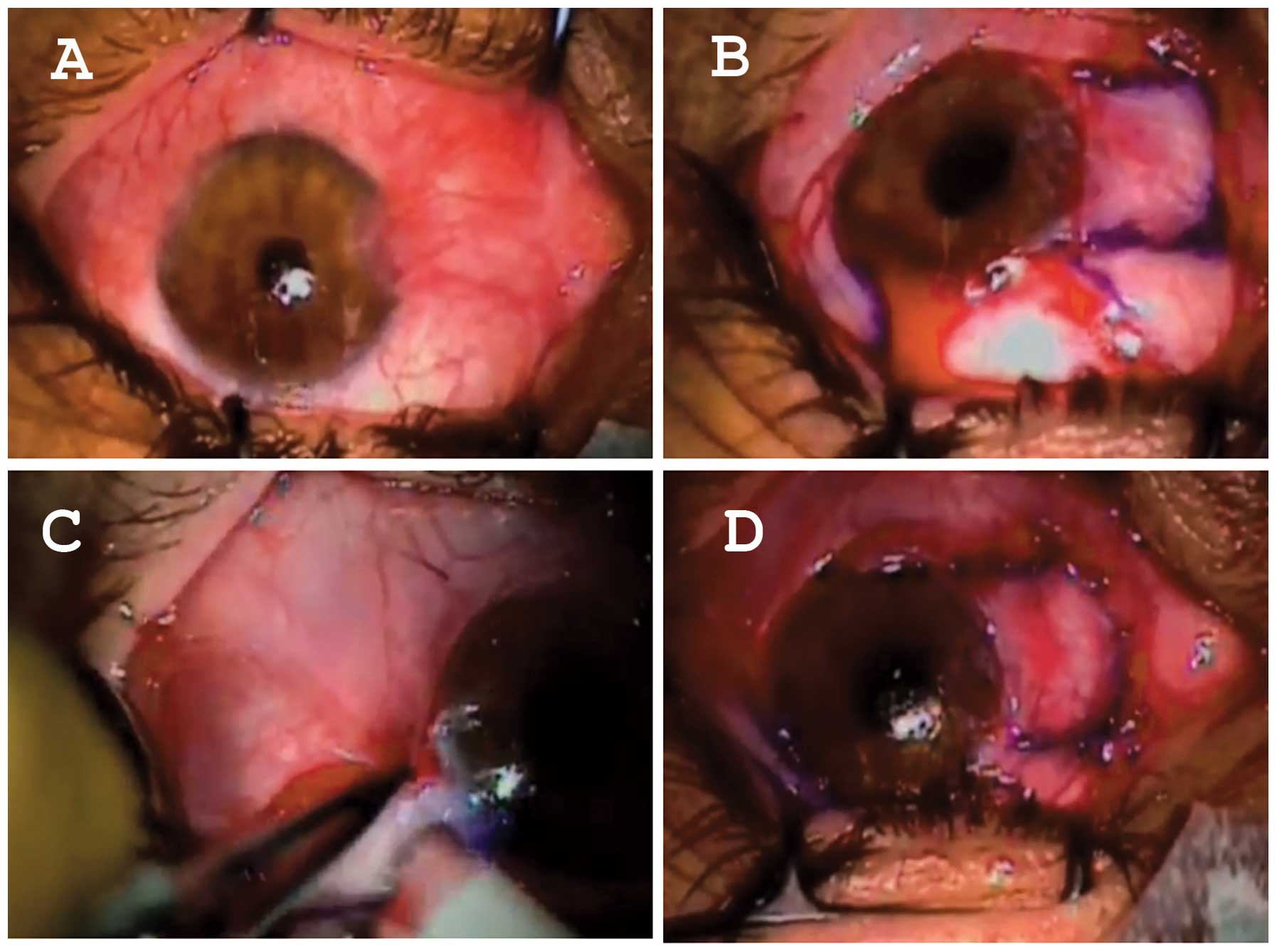|
1
|
Detorakis ET and Spandidos DA:
Pathogenetic mechanisms and treatment options for ophthalmic
pterygium: Trends and perspectives (Review). Int J Mol Med.
23:439–447. 2009. View Article : Google Scholar : PubMed/NCBI
|
|
2
|
Hirst LW: The Treatment of pterygium. Surv
Ophthalmol. 48:145–180. 2003. View Article : Google Scholar
|
|
3
|
Coroneo MT: Pterygium as an early
indicator of ultraviolet insolation: a hypothesis. Br J Ophthalmol.
77:734–739. 1993. View Article : Google Scholar : PubMed/NCBI
|
|
4
|
Chui J, Coroneo MT, Tat LT, Crouch R,
Wakefield D and Di Girolamo N: Ophthalmic pterygium: a stem cell
disorder with premalignant features. Am J Pathol. 178:817–827.
2011. View Article : Google Scholar : PubMed/NCBI
|
|
5
|
Detorakis ET, Zaravinos A and Spandidos
DA: Growth factor expression in ophthalmic pterygia and normal
conjunctiva. Int J Mol Med. 25:513–516. 2010. View Article : Google Scholar : PubMed/NCBI
|
|
6
|
Di Girolamo N, Wakefield D and Coroneo MT:
Differential expression of matrix metalloproteinases and their
tissue inhibitors at the advancing pterygium head. Invest
Ophthalmol Vis Sci. 41:4142–4149. 2000.PubMed/NCBI
|
|
7
|
Tsai YY, Chiang CC, Yeh KT, Lee H and
Cheng YW: Effect of TIMP-1 and MMP in pterygium invasion. Invest
Ophthalmol Vis Sci. 51:3462–3467. 2010. View Article : Google Scholar : PubMed/NCBI
|
|
8
|
Aspiotis M, Tsanou E, Gorezis S, Ioachim
E, Skyrlas A, Stefaniotou M and Malamou-Mitsi V: Angiogenesis in
pterygium: study of microvessel density, vascular endothelial
growth factor, and thrombospondin-1. Eye (Lond). 21:1095–1101.
2007. View Article : Google Scholar : PubMed/NCBI
|
|
9
|
Solomon A, Li DQ, Lee SB and Tseng SC:
Type plasminogen activator in primary pterygium body fibroblasts by
inflammatory cytokines. Invest Ophthalmol Vis Sci. 41:2154–2163.
2000.PubMed/NCBI
|
|
10
|
Solomon A, Grueterich M, Li DQ, Meller D,
Lee SB and Tseng SC: Overexpression of insulin-like growth
factor-binding protein-2 in pterygium body fibroblasts. Invest
Ophthalmol Vis Sci. 44:573–580. 2003. View Article : Google Scholar : PubMed/NCBI
|
|
11
|
Detorakis ET, Sourvinos G, Tsamparlakis J
and Spandidos DA: Evaluation of loss of heterozygosity and
microsatellite instability in human pterygium: clinical
correlations. Br J Ophthalmol. 82:1324–1328. 1998. View Article : Google Scholar : PubMed/NCBI
|
|
12
|
Dushku N, Hatcher SL, Albert DM and Reid
TW: P53 expression and relation to human papillomavirus infection
in pingueculae, pterygia, and limbal tumors. Arch Ophthalmol.
117:1593–1599. 1999. View Article : Google Scholar : PubMed/NCBI
|
|
13
|
Soussi T, Dehouche K and Béroud C: P53
website and analysis of P53 gene mutations in human cancer: forging
a link between epidemiology and carcinogenesis. Hum Mutat.
15:105–113. 2000. View Article : Google Scholar : PubMed/NCBI
|
|
14
|
Freed-Pastor WA and Prives C: Mutant p53:
one name, many proteins. Genes Dev. 26:1268–1286. 2012. View Article : Google Scholar : PubMed/NCBI
|
|
15
|
Detorakis ET, Drakonaki EE and Spandidos
DA: Molecular genetic alterations and viral presence in ophthalmic
pterygium. Int J Mol Med. 6:35–41. 2000.PubMed/NCBI
|
|
16
|
Tsai YY, Chang CC, Chiang CC, Yeh KT, Chen
PL, Chang CH, Chou MC, Lee H and Cheng YW: HPV infection and p53
inactivation in pterygium. Mol Vis. 15:1092–1097. 2009.PubMed/NCBI
|
|
17
|
Burk RD, Chen Z and Van Doorslaer K: Human
papillomaviruses: genetic basis of carcinogenicity. Public Health
Genomics. 12:281–290. 2009. View Article : Google Scholar : PubMed/NCBI
|
|
18
|
Detorakis ET, Sourvinos G and Spandidos
DA: Detection of herpes simplex virus and human papilloma virus in
ophthalmic pterygium. Cornea. 20:164–167. 2001. View Article : Google Scholar : PubMed/NCBI
|
|
19
|
Gallagher MJ, Giannoudis A, Herrington CS
and Hiscott P: Human papillomavirus in pterygium. Br J Ophthalmol.
85:782–784. 2001. View Article : Google Scholar : PubMed/NCBI
|
|
20
|
Piras F, Moore PS, Ugalde J, Perra MT,
Scarpa A and Sirigu P: Detection of human papillomavirus DNA in
pterygia from different geographical regions. Br J Ophthalmol.
87:864–866. 2003. View Article : Google Scholar : PubMed/NCBI
|
|
21
|
Schellini SA, Hoyama E, Shiratori CA,
Sakamoto RH and Candeias JM: Lack of papillomavirus (HPV) in
pterygia of a Brazilian sample. Arq Bras Oftalmol. 69:519–521.
2006. View Article : Google Scholar : PubMed/NCBI
|
|
22
|
Sjö NC, von Buchwald C, Prause JU, Norrild
B, Vinding T and Heegaard S: Human papillomavirus and pterygium. Is
the virus a risk factor? Br J Ophthalmol. 91:1016–1018.
2007.PubMed/NCBI
|
|
23
|
Takamura Y, Kubo E, Tsuzuki S and Akagi Y:
Detection of human papillomavirus in pterygium and conjunctival
papilloma by hybrid capture II and PCR assays. Eye (Lond).
22:1442–1445. 2008. View Article : Google Scholar : PubMed/NCBI
|
|
24
|
Rodrigues FW, Arruda JT, Silva RE and
Moura KK: Polymorphism and human papillomavirus DNA associated with
pterygium. Genet Mol Res. 7:1251–1258. 2008. View Article : Google Scholar : PubMed/NCBI
|
|
25
|
Otlu B, Emre S, Turkcuoglu P, Doganay S
and Durmaz R: Investigation of human papillomavirus and
Epstein-Barr virus DNAs in pterygium tissue. Eur J Ophthalmol.
19:175–179. 2009.PubMed/NCBI
|
|
26
|
Piecyk-Sidor M, Polz-Dacewicz M, Zagórski
Z and Zarnowski T: Occurrence of human papillomavirus in pterygia.
Acta Ophthalmol. 87:890–895. 2009. View Article : Google Scholar : PubMed/NCBI
|
|
27
|
Hsiao CH, Lee BH, Ngan KW, Chuang WY,
Yeung L, Yeh LK, Tan HY, Hui-Kang D and Lin KK: Presence of human
papillomavirus in pterygium in Taiwan. Cornea. 29:123–127. 2010.
View Article : Google Scholar : PubMed/NCBI
|
|
28
|
Spandidos D, Xinarianos G, Ergazaki M,
Giannoudis A and Tsamparlakis J: The presence of herpesviruses in
pterygium. Int J Oncol. 5:749–752. 1994.PubMed/NCBI
|
|
29
|
Chen YF, Hsiao CH, Ngan KW, Yeung L, Tan
HY, Yang KH, Huang SC and Lin KK: Herpes simplex virus and
pterygium in Taiwan. Cornea. 27:311–313. 2008. View Article : Google Scholar : PubMed/NCBI
|
|
30
|
Karcioglu ZA and Issa TM: Human papilloma
virus in neoplastic and non-neoplastic conditions of the external
eye. Br J Ophthalmol. 81:595–598. 1997. View Article : Google Scholar : PubMed/NCBI
|
|
31
|
McDonnell JM, McDonnell PJ and Sun YY:
Human papillomavirus DNA in tissues and ocular surface swabs of
patients with conjunctival epithelial neoplasia. Invest Ophthalmol
Vis Sci. 33:184–189. 1992.PubMed/NCBI
|
|
32
|
Saegusa M, Takano Y, Hashimura M, Okayasu
I and Shiga J: HPV type 16 in conjunctival and junctional
papilloma, dysplasia, and squamous cell carcinoma. J Clin Pathol.
48:1106–1110. 1995. View Article : Google Scholar : PubMed/NCBI
|
|
33
|
Sjö NC, Heegaard S, Prause JU, von
Buchwald C and Lindeberg H: Human papillomavirus in conjunctival
papilloma. Br J Ophthalmol. 85:785–787. 2001.
|
|
34
|
Sjö NC, von Buchwald C, Cassonnet P,
Norrild B, Prause JU, Vinding T and Heegaard S: Human
papillomavirus in normal conjunctival tissue and in conjunctival
papilloma: types and frequencies in a large series. Br J
Ophthalmol. 91:1014–1015. 2007.PubMed/NCBI
|
|
35
|
Kiire CA and Dhillon B: The aetiology and
associations of conjunctival intraepithelial neoplasia. Br J
Ophthalmol. 90:109–113. 2006. View Article : Google Scholar : PubMed/NCBI
|
|
36
|
Ateenyi-Agaba C, Franceschi S,
Wabwire-Mangen F, Arslan A, Othieno E, Binta-Kahwa J, van Doorn LJ,
Kleter B, Quint W and Weiderpass E: Human papillomavirus infection
and squamous cell carcinoma of the conjunctiva. Br J Cancer.
102:262–267. 2010. View Article : Google Scholar : PubMed/NCBI
|
|
37
|
Hirst LW, Axelsen RA and Schwab I:
Pterygium and associated ocular surface squamous neoplasia. Arch
Ophthalmol. 127:31–32. 2009. View Article : Google Scholar : PubMed/NCBI
|
|
38
|
Artornsombudh P, Sanpavat A,
Tinnungwattana U, Tongkhomsai V, Sansopha L and Tulvatana W:
Prevalence and clinicopathologic findings of conjunctival
epithelial neoplasia in pterygia. Ophthalmology. 120:1337–1340
|
|
39
|
Bandyopadhyay R, Nag D, Mondal SK,
Gangopadhyay S, Bagchi K and Bhaduri G: Ocular surface disorder in
pterygium: role of conjunctival impression cytology. Indian J
Pathol Microbiol. 53:692–695. 2010. View Article : Google Scholar : PubMed/NCBI
|
|
40
|
Abreu AL, Souza RP, Gimenes F and
Consolaro ME: A review of methods for detect human Papillomavirus
infection. Virol J. 9:2622012. View Article : Google Scholar : PubMed/NCBI
|
|
41
|
Molijn A, Kleter B, Quint W and van Doorn
LJ: Molecular diagnosis of human papillomavirus (HPV) infections. J
Clin Virol. 32(Suppl 1): S43–S51. 2005. View Article : Google Scholar : PubMed/NCBI
|
|
42
|
Leto Md, Santos Júnior GF, Porro AM and
Tomimori J: Human papillomavirus infection: etiopathogenesis,
molecular biology and clinical manifestations. An Bras Dermatol.
86:306–317. 2011.(In English, Portuguese).
|
|
43
|
Mackay IM: Real-time PCR in the
microbiology laboratory. Clin Microbiol Infect. 10:190–212. 2004.
View Article : Google Scholar : PubMed/NCBI
|
|
44
|
Bustin SA, Benes V, Nolan T and Pfaffl MW:
Quantitative real-time RT-PCR - a perspective. J Mol Endocrinol.
34:597–601. 2005. View Article : Google Scholar : PubMed/NCBI
|
|
45
|
Jensen EC: Real-time reverse transcription
polymerase chain reaction to measure mRNA: use, limitations, and
presentation of results. Anat Rec (Hoboken). 295:1–3. 2012.
View Article : Google Scholar : PubMed/NCBI
|
|
46
|
Todani A and Melki SA: Pterygium current
concepts in pathogenesis and treatment. Int Ophthalmol Clin.
49:21–30. 2009.PubMed/NCBI
|
|
47
|
Jonasch E and Haluska FG: Interferon in
oncological practice: review of interferon biology, clinical
applications, and toxicities. Oncologist. 6:34–55. 2001. View Article : Google Scholar : PubMed/NCBI
|
|
48
|
Vann RR and Karp CL: Perilesional and
topical interferon alfa-2b for conjunctival and corneal neoplasia.
Ophthalmology. 106:91–97. 1999. View Article : Google Scholar : PubMed/NCBI
|
|
49
|
Karp CL, Moore JK and Rosa RH Jr:
Treatment of conjunctival and corneal intraepithelial neoplasia
with topical interferon alpha-2b. Ophthalmology. 108:1093–1098.
2001. View Article : Google Scholar : PubMed/NCBI
|
|
50
|
Schechter BA, Schrier A, Nagler RS, Smith
EF and Velasquez GE: Regression of presumed primary conjunctival
and corneal intraepithelial neoplasia with topical interferon
alpha-2b. Cornea. 21:6–11. 2002. View Article : Google Scholar : PubMed/NCBI
|
|
51
|
Schechter BA, Rand WJ, Velazquez GE,
Williams WD and Starasoler L: Treatment of conjunctival papillomata
with topical interferon Alfa-2b. Am J Ophthalmol. 134:268–270.
2002. View Article : Google Scholar : PubMed/NCBI
|
|
52
|
Esquenazi S: Treatment of early pterygium
recurrence with topical administration of interferon alpha-2b. Can
J Ophthalmol. 40:185–187. 2005. View Article : Google Scholar : PubMed/NCBI
|












